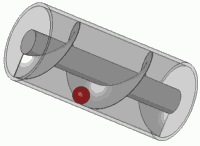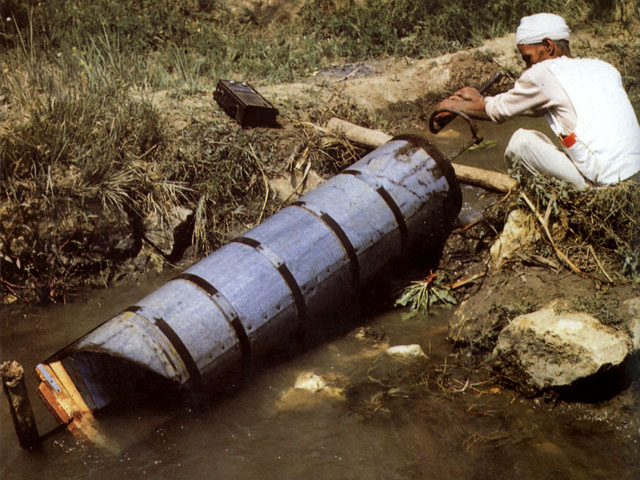Difference between revisions of "Archimedes screw"
| Line 15: | Line 15: | ||
The Archimedes Screw is still used today in some limited applications (usually electrically-powered), and can range in size from a quarter of an inch to nearly 4 meters (12 feet) in diameter. A large screw or banks of screws may be used to pump rainstorm runoff or to lift water or wastewater, for example. | The Archimedes Screw is still used today in some limited applications (usually electrically-powered), and can range in size from a quarter of an inch to nearly 4 meters (12 feet) in diameter. A large screw or banks of screws may be used to pump rainstorm runoff or to lift water or wastewater, for example. | ||
| + | Archimedes' screws, now called screw conveyors, are also used today primarily to propel dry bulk materials. However, if you do not have access to a generator pump and need a low-tech solution to raise water, it doesn't get much easier and low-tech than an Archimedes' screw.<ref> [http://www.ehow.com/how_8725014_build-handpowered-water-pump.html How to build and hand-powered water pump.] By Andrew Latham, eHow Contributor.</ref> | ||
| + | |||
| + | Read more: How to Build a Hand-Powered Water Pump | eHow.com http://www.ehow.com/how_8725014_build-handpowered-water-pump.html#ixzz2BQ6rI8E6 | ||
| + | |||
| + | ==References== | ||
| + | <references/> | ||
==Acknowledgements== | ==Acknowledgements== | ||
* [http://www.waterencyclopedia.com/Po-Re/Pumps-Traditional.html#b Pumps, traditional]. Waterencyclopedia.com. | * [http://www.waterencyclopedia.com/Po-Re/Pumps-Traditional.html#b Pumps, traditional]. Waterencyclopedia.com. | ||
Revision as of 07:11, 6 November 2012



The Archimedes Screw (named after a Greek mathematician) is though to have been around since 250 B.C.E.
The Archimedes Screw is basically a large helix, open at both ends and encased within a watertight cylinder. It operates with the cylinder somewhat tilted from vertical. When the open lower end of the cylinder is placed in water and the screw is turned, water trapped between the cylinder and the threads of the screw rises. Successive revolutions will raise the water thread-by-thread until it emerges at the top of the cylinder.
It can be used where the water needs to be raised less than 1.5 meters (5 feet). In such cases, it is perhaps the most efficient of the ancient methods, because two men can raise an enormous volume of water in less than an hour. The Archimedes Screw has been widely used over the centuries, especially to raise irrigation water and for land drainage, often being powered by people or animals. Besides being of simple construction, it has the additional advantage of being able to move water that contains mud, sand, or gravel.
The Archimedes Screw is still used today in some limited applications (usually electrically-powered), and can range in size from a quarter of an inch to nearly 4 meters (12 feet) in diameter. A large screw or banks of screws may be used to pump rainstorm runoff or to lift water or wastewater, for example.
Archimedes' screws, now called screw conveyors, are also used today primarily to propel dry bulk materials. However, if you do not have access to a generator pump and need a low-tech solution to raise water, it doesn't get much easier and low-tech than an Archimedes' screw.1
Read more: How to Build a Hand-Powered Water Pump | eHow.com http://www.ehow.com/how_8725014_build-handpowered-water-pump.html#ixzz2BQ6rI8E6
References
- ↑ How to build and hand-powered water pump. By Andrew Latham, eHow Contributor.
Acknowledgements
- Pumps, traditional. Waterencyclopedia.com.
